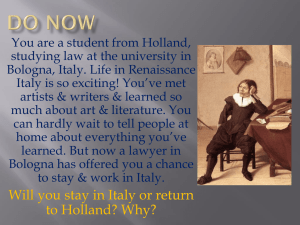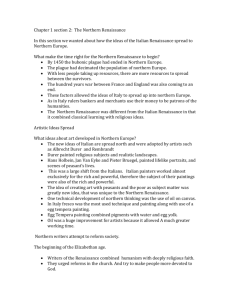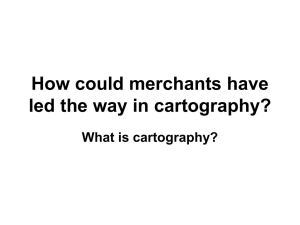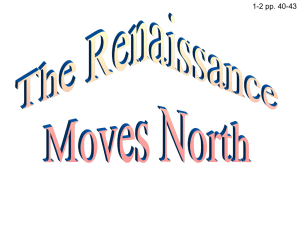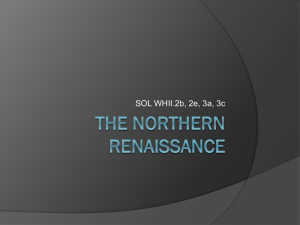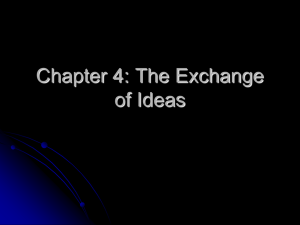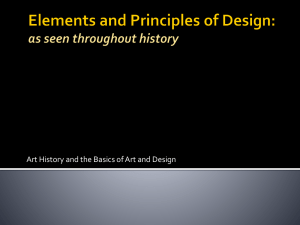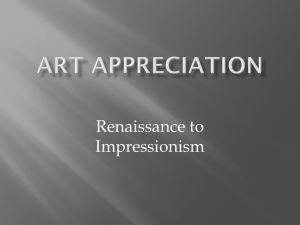WH_Chpt1_Sect2
advertisement
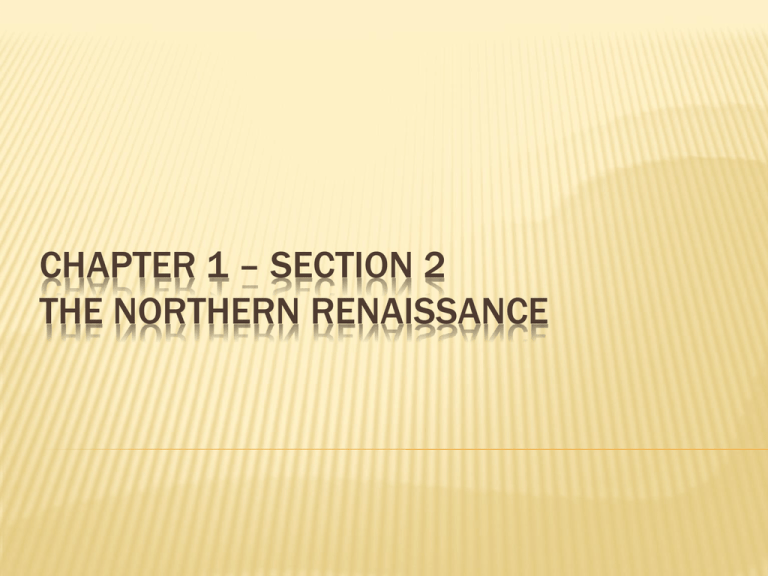
CHAPTER 1 – SECTION 2 THE NORTHERN RENAISSANCE THE NORTHERN RENAISSANCE The Northern Renaissance begins The time was right…but why? 1450, the population began to rebound from the Bubonic Plague 1453, the Hundred Years’ War ended between England and France How did the ideas spread to Northern Europe and why? 1494, a French king took control of Naples, Italy. He looted and plundered Italy and his reign spread North. Artists, writers, scientists and the like fled like cockroaches out of Italy and made their way North through Europe. Do you think they brought their ideas with them? What ideas did tthey bring with them? THE NORTHERN RENAISSANCE German Painters Albrecht He Durer traveled to Italy to study in 1494. fled back to Germany when the French took control. His works obviously portrayed realism and portraits of people (like our modern day photographer). A big contribution was that he inspired other German artists to adopt the Renaissance way of art. On of Durer’s protégés was German artist Hans Holbein the Younger. Specialized in creating portraits that were almost photographic in quality. THE NORTHERN RENAISSANCE Flemish Painter Mainly wealthy merchant families that made Flanders the artistic center of Europe Well-know Flemish artist was Jan van Eyck develop the art of oil painting. Why? It does not dry as quick It can blend to develop a variety of colors It can be layered to produce stunning effects Also, Flemish painter started to use a variety of tools to paint, not just paint brushes. http://www.youtube.com/watch?v=_j7SGoRdOL8&feat ure=related THE NORTHERN RENAISSANCE Northern Writers Reform Society Christian Humanists Desiderius Erasmus wrote Praise of Folly Erasmus and Thomas More Made fun of: wealthy people, “schmoopie woopie” lovers, scholars that argued, and arrogant priests He believed in Christianity of the heart, not religious ceremonies Thomas More Created Utopia. a mode in 1516 of the perfect society in his book No crime, greed, adultery, theft, arguments Wanted a land of peace and serenity THE NORTHERN RENAISSANCE William Shakespeare wrote in Renaissance England He brought to light dramatic scenes of life through showing the true character of people and the emotions that run through them He examined the flaws in humans and the consequences that come with them. Printing Spreads Renaissance Ideas (A Revolution in Knowledge and Thought) Johann Gutenberg from Mainz, Germany, reinvented movable type around 1440. Great for Europeans because their alphabet was smaller than the Chinese alphabet. He invented the printing press A machine that presses paper against a tray full of inked movable type (little metal letters). He used it to print the 1st book, The (Gutenberg) Bible in about 1455 (1st fullsized book) THE NORTHERN RENAISSANCE The Printing Press Spreads Learning!!! How did your hand feel last week after writing your paragraph? How do you think it would have felt if you had to write an entire book? How about a few hundred books? Well…the printing press allowed authors to distribute numerous copies of their works This allowed books to become cheaper, so most anyone could buy them. Also, new ideas spread more quickly. Printed in vernacular which encouraged people to read, learn, become literate and apply their new found understanding. As we know, the 1st book that was printed in mass, was the Gutenberg Bible. People began to interpret the Bible for themselves. This led the same people to understand the Bible and question the priests and their behavior. Led to reforms among the Church and spurred revolutionaries to interpret the Bible further and create new and more appealing religions!!! NOW IT’S YOUR TURN TO TEACH THE CLASS!!! Students will be given strips of bulletin-board paper. They will begin to construct a timeline of important events/individual’s impact on the Renaissance and Reformation (should include a brief statement[2-3 sentences] of what happened and a picture. They will be expected to add 10 events or individual contributions from every section of the text assigned for reading (totaling 30 items). This will be an ongoing assignment lasting 3 days. Text/pictures/timeline should be large enough to see from different areas of the room as the timelines can be used on the Chapter Test, so students should definitely collaborate with other groups as to not have duplicate timelines. ***(The timelines should include Sections 1, 2, & 3 from Chapter 1.)*** Next to students’ timelines, students will create a logo and a motto for the Renaissance on an 8 1/2 x 11 piece of paper. Once the timeline is finished, which will be Thursday, Sept. 27, students will turn in a brief summary (1paragraph) answering the following essential question: In the early 1300s, Europeans evolved past the ideas of the Middle Ages and their artistic, political, religious, and social structures. How did the printing press contribute to this revolution of thought and evolution? Students will present their work to the class on Friday, Sept. 28, and should be able to defend it. All members will present their group’s ideas to the class and defend it with minor support from other group members. (6 minutes per group) Items to review that defined the Renaissance (technology, science, shifts in religious ideals, art, and humanitarian thought). These topics are interconnected and will arise throughout the year; identifying them now will aid the students later. Assessment: Students will be assessed on their participation in class and group discussion as well as their paragraph on why the printing press created a massive revolution in thought. Additionally, students will be assessed on how their group members viewed their contributions and by Mr. N for honest feedback about their group member that correlates with what Mr. N observed. Everybody should be actively participating and pulling their own weight. Goofing around and side conversations not relating to class will not be tolerated!!!

